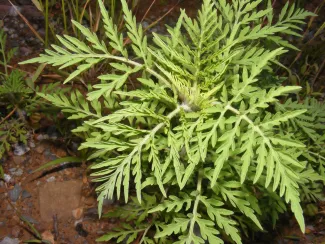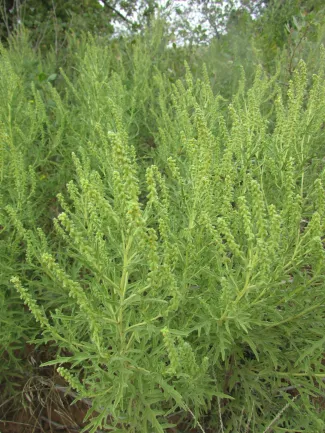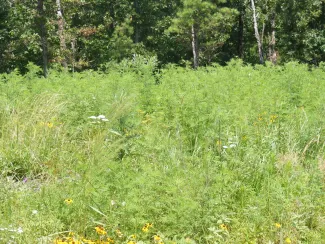Many plants are targeted as undesirable “weeds” each year, and ragweed is certainly among the list. However, some species are highly important and prized wildlife foods that deserve a second thought before any mowing or spraying regimen is employed for their control.
By in large, the four most common species of ragweed that Oklahomans encounter are annual, giant, lanceleaf, and western. The food value of the giant and lanceleaf varieties is rather low, especially with regard to their seed value. However, the food value of the annual and western varieties can be very high.

Annual ragweed. (Photo by Kyle Johnson/ODWC)

Western ragweed. (Photo by Kyle Johnson/ODWC)
In all, more than four dozen birds consume ragweed seeds, especially those of annual and western varieties. The seeds are high in energy, and this is something birds and other animals need during the fall and winter months when temperatures drop and food is limited. Songbirds, mourning dove, ring-necked pheasant, prairie-chicken, scaled quail, and northern bobwhite all consume large quantities of seed, but, to demonstrate the importance of ragweed seed, let us look at the bobwhite.
From 2013 to 2019, the Wildlife Department analyzed the dietary (crop) contents of 891 Oklahoma-harvested wild bobwhite quail. More than 167 different seed types were found in the study, but, by far, the number one dietary item was ragweed seeds, both in terms of how frequent they were eaten and their overall dietary volume. Of the ragweed seeds eaten, nearly all were from annual and western varieties. As a comparison, seeds from such notable wildlife foods as wild sunflowers and crotons were also consumed in large quantities, but still far less than ragweeds. The good news is that these plant communities often abound where sunflowers and crotons also occur, so managing for one usually provides the food benefits of each for wildlife.

Ragweeds provide excellent brood cover for species like bobwhite quail. (Photo by Kyle Johnson/ODWC)
But it’s not just quail and other birds that consume high quantities of ragweed seeds; high use has also been reported for ground squirrels and other small mammals. Low to moderate seasonal use of various portions of the plants have been noted in the diet of mule deer, white-tailed deer, pronghorn, cottontail rabbits, and swamp rabbits. For pronghorn, less than 10 percent seasonal use has been reported. Annual ragweed appears to be of more benefit to white-tailed deer than other species within the state.
Another facet to consider is the indirect food benefits the plants provide. Although the flowers are largely wind-pollinated, the plants are well-known for attracting a variety of insects that foraging birds and mammals eagerly eat, especially grasshoppers. However, various moths, seed bugs, leaf beetles, longhorn beetles, froghoppers and more are commonly found using ragweed plants for food and cover. This, coupled with the great cover that most ragweeds provide, make these plant communities ideal brood habitat for species like quail that readily use them when they are available.
Overall, ragweed communities can look “weedy” and undesirable, but giving these species a little extra attention before any control practice is undertaken can make a big difference for the wildlife on your property.